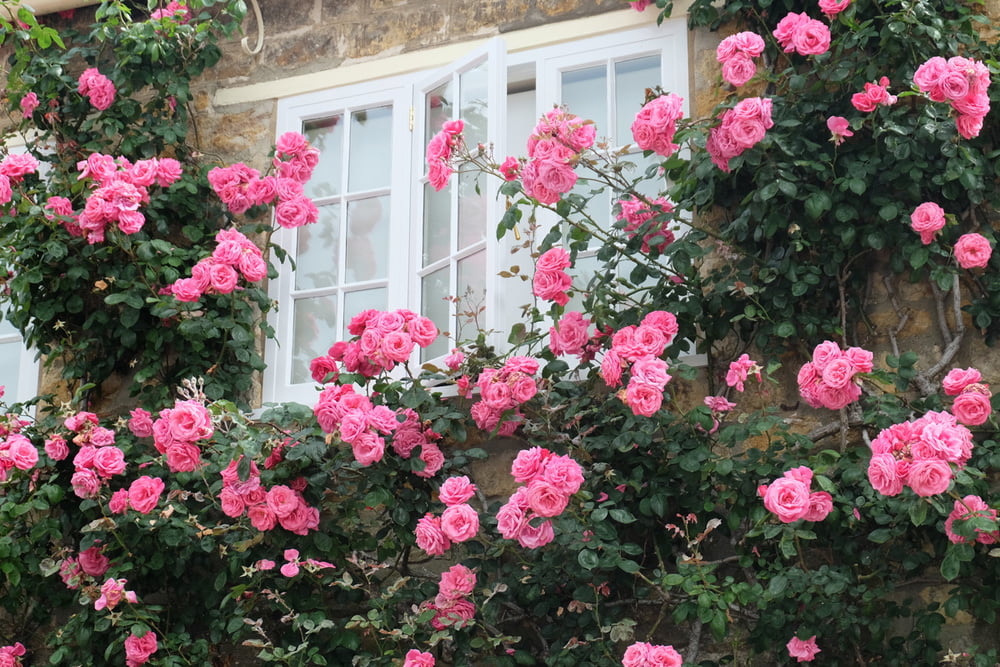Climbing roses captivate with their lush growth and flowering. For your climbing rose to grow and bloom properly, the right pruning is crucial. We explain how to prune climbing roses correctly.
In order for climbing roses to grow vigorously and remain healthy, proper climbing rose pruning is essential. During this process, you remove dead and diseased parts of the plant, competing shoots and bring the plant into a healthy and beautiful shape.
The best time to do this is in the spring in March or April.
With climbing roses, a distinction must be made between varieties that bloom once – known as ramblers – and climbers that bloom several times.
While ramblers, which were bred from wild roses and hedge roses, are also quite uncomplicated when it comes to pruning, there are a few things to consider with the large-flowered climbers.
Contents
Rule of thumb for pruning climbing roses
Once-flowering climbing roses should be pruned once a year, in the spring in March or April.
Multiple flowering climbing roses, on the other hand, you cut several times: in the spring and again after the second flowering in the fall.
Pruning multiple flowering climbing roses
Multiple-flowering climbing roses are also called climbers. They reach a height of up to 3.5 meters and bloom from May to the end of June and again between August and November.
For the plant, however, the two flowering peaks mean a great effort. The rose compensates for this by forming a basic framework of very short and firm shoots, from which softer side shoots form, which also produce the flowers.
Therefore, when pruning climbing roses for multiple flowering roses, simply cut back the weaker side shoots to the basic structure in the spring.
You can also support the climbing rose by attaching the firmer shoots to a climbing aid to which the flowering shoots can “hold on”.
In this way, the Climber Roses also offer themselves as an attractive privacy screen solution.
By the way: Here we explain how to weld a climbing aid yourself.
Cutting climbing roses in spring
March and April, around the time of forsythia bloom, is the optimal time to prune climbing roses in spring.
Shorten the young side shoots to within 3 to 5 eyes of the trunk.
Older climbing roses may have bare shoots toward the ground.
You can also cut back these older bare shoots – this allows light and air into the basic structure of the rose.
Summer pruning for climbing roses
Summer pruning stimulates the rose to produce more flowers. To do this, cut back the faded rose flowers just below the first fully formed leaf. In this way, the rose does not form seeds, but more flowers.
After the first flowering, you can cut back the faded young shoots about two-thirds of the shoot length to a shootable eye in about June.
The cut should be about the diameter of a wooden peg.
Do not shorten shoots in the lower third of the rose, but tie them to the trellis so that the rose also looks full from below.
Prune rambler climbing roses
Since once-flowering climbing roses or rambler roses do not form a basic framework, you need to take a slightly different approach to pruning here. Rambler roses can grow up to 10 feet tall.
They form long, flexible shoots that need to be thinned regularly to rejuvenate the rose and prevent the plant from choking on itself. Too dense a tangle of tendrils also encourages disease and pests.
It is recommended that rambler roses not be pruned for the first time until they are five years old.
Simply cut the older shoots close to the ground every two years and pull them out of the rose bush.
There is no need for maintenance pruning altogether.
Every 7 years in February rambler roses need rejuvenation pruning, removing old shoots to make way for the younger and stronger shoots. To do this, simply cut the shoots to be removed at the base and carefully pull them out of the rose bush.
You can cut back the faded rose blossoms to below the first developed leaf, or you can simply let nature take its course: in this case, rambler roses, just like their wild relatives, produce rose hips, which the birds also enjoy in winter.
Wild climbing roses also need care. If you prune your climbing roses regularly, you can enjoy healthy, beautiful plants for a long time to come.


